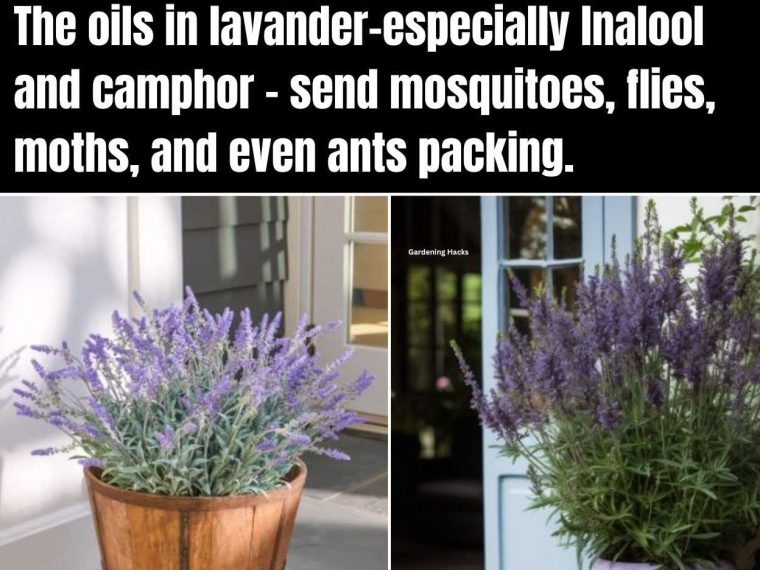Lavender isn’t just a fragrant and beautiful herb – it’s a symbol of peace, protection, and prosperity.
Gardeners, homeowners, and herbal enthusiasts alike are discovering the incredible benefits of placing a lavender plant near their front door or entryway.
Whether you grow it in a pot or directly in the soil, lavender brings a unique combination of beauty, function, and symbolism to your home’s entrance.
In this comprehensive guide, we’ll explore why lavender is more than just an ornamental herb.
From its calming fragrance to pest-repelling powers, we’ll look at the many reasons why this plant deserves a permanent spot at your entryway, how to grow it for maximum success, and what variety to choose for your location.
1. Symbolism and Traditional Beliefs Around Lavender
Throughout history, lavender has been considered a sacred herb. In ancient Rome and Greece, it was burned as incense at doorways to ward off evil spirits.
In medieval Europe, it was hung in doorways to protect against plague and misfortune.
Today, many gardeners and holistic home decorators place a potted lavender plant at the front door to invite peace, calm, and emotional balance into the home.
Lavender is also known to represent cleanliness, grace, and purity. The act of welcoming guests with a plant that symbolizes calm and comfort sets a warm and inviting tone even before they walk in.
2. A Natural Air Freshener
One of lavender’s most appreciated qualities is its clean, relaxing scent. The fragrance comes from essential oils in the plant’s leaves and flowers, which naturally release aroma into the surrounding air.
When placed near a doorway, even a gentle breeze can carry the calming scent into your home.
Lavender’s fresh scent can:
- Reduce stress and anxiety
- Promote feelings of well-being
- Encourage deeper breathing
- Create a tranquil environment
Unlike artificial air fresheners, lavender’s aroma is natural and free of harmful chemicals.
3. Pest-Repelling Properties
Lavender is a natural pest deterrent. Its essential oils – particularly linalool and camphor – repel insects like mosquitoes, moths, fleas, and flies.
That makes it a valuable plant to keep near your entryway, where bugs might try to enter the house.
Here are some pests lavender can help repel: Mosquitoes, Flies, Ants, Moths, Ticks.
Growing lavender near the entrance serves as a first line of defense against common garden and household pests, especially during the warmer months.
4. Visual Appeal and Curb Appeal
Lavender’s striking purple-blue flowers and silvery-green foliage create a beautiful visual contrast, especially when planted in terracotta pots or stone planters.
The upright, bushy form gives structure to entryway gardens and draws attention to the doorway.
Adding lavender to your home’s front entrance enhances curb appeal by:
- Creating a vibrant, fragrant border
- Drawing pollinators like bees and butterflies
- Offering year-round foliage interest
- Matching well with other Mediterranean or drought-tolerant plants like rosemary, sage, and thyme.
5. Easy to Grow and Maintain
Lavender is well-loved not just for its beauty, but also for its resilience. It’s relatively low-maintenance when grown in the right conditions. Here’s how to grow it successfully in your entryway:
Sunlight:
Lavender thrives in full sun. Ensure your entryway receives at least 6–8 hours of sunlight per day.
Soil:
Use well-draining soil. Lavender doesn’t like wet roots. Sandy or loamy soils are ideal.
Watering:
Once established, lavender is drought-tolerant. Water deeply but infrequently, allowing the soil to dry out between waterings.
Pruning:
Trim back plants once or twice a year to encourage bushiness and prevent woodiness.
Fertilizing:
Avoid over-fertilizing. A small amount of compost or a light organic fertilizer in spring is usually enough.
6. Ideal Varieties for Entryways
Not all lavender varieties are the same. Here are some top picks for growing near your front door:
English Lavender (Lavandula angustifolia)
- Compact size
- Highly fragrant
- Cold-hardy (Zones 5–9)
- Best for culinary and aromatherapy uses
French Lavender (Lavandula dentata)
- Frilly leaves with a lighter scent
- Less cold hardy (Zones 7–10)
- Great for pots and visual appeal
Spanish Lavender (Lavandula stoechas)
- Distinctive “rabbit ears” atop flowers
- Tolerates heat better
- Strong scent and quick blooming
Choose a variety based on your climate, space, and desired appearance.
7. Lavender in Feng Shui and Home Energy
In Feng Shui, lavender is associated with calming energy and balance. Placing it near your front entrance encourages positive energy to flow into the home.
It is believed to promote:
- Harmony within the household
- Emotional healing
- Clarity of thought
- Reduction of tension and negativity
In holistic homes, lavender at the doorway acts as a living energy filter, helping to create a peaceful home environment.
8. Attracting Pollinators and Supporting Local Ecology
Lavender is a magnet for pollinators like bees, butterflies, and hoverflies. Having a lavender plant at your entryway supports biodiversity and gives these beneficial creatures a valuable food source.
By attracting pollinators, you also support nearby vegetable gardens, fruit trees, and flowering plants.
Lavender contributes to a healthy garden ecosystem while adding life and motion to your front yard.
9. Lavender as a Welcoming Gift
In many cultures, gifting lavender is a symbol of goodwill, tranquility, and luck. If you’re having guests over, a potted lavender plant near the entrance can make them feel more welcome and comforted.
It’s a small gesture that leaves a lasting impression.
Additionally, you can harvest some stems to use in sachets or bouquets to give as parting gifts, housewarming presents, or tokens of appreciation.
10. Container Ideas for Lavender
Lavender looks great in decorative containers that match your home’s exterior. Choose pots that are:
- Made from terracotta, clay, or stone
- At least 12 inches in diameter
- Equipped with drainage holes
Lavender’s roots don’t like to be waterlogged, so use a cactus or Mediterranean-style potting mix for best results.
To make the container even more beautiful:
- Add small stones or gravel on the surface
- Pair with low-growing herbs like creeping thyme
- Place pots symmetrically on each side of the door
In Feng Shui, lavender is associated with calming
- Harmony within the household
- Emotional healing
- Clarity of thought
- Reduction of tension and negativity
In holistic homes, lavender at the doorway acts as a living energy filter, helping to create a peaceful home environment.
8. Attracting Pollinators and Supporting Local Ecology
Lavender is a magnet for pollinators like bees, butterflies, and hoverflies. Having a lavender plant at your entryway supports biodiversity and gives these beneficial creatures a valuable food source.
By attracting pollinators, you also support nearby vegetable gardens, fruit trees, and flowering plants.
Lavender contributes to a healthy garden ecosystem while adding life and motion to your front yard.
9. Lavender as a Welcoming Gift
In many cultures, gifting lavender is a symbol of goodwill, tranquility, and luck. If you’re having guests over, a potted lavender plant near the entrance can make them feel more welcome and comforted.
It’s a small gesture that leaves a lasting impression.
Additionally, you can harvest some stems to use in sachets or bouquets to give as parting gifts, housewarming presents, or tokens of appreciation.
10. Container Ideas for Lavender
Lavender looks great in decorative containers that match your home’s exterior. Choose pots that are:
- Made from terracotta, clay, or stone
- At least 12 inches in diameter
- Equipped with drainage holes
Lavender’s roots don’t like to be waterlogged, so use a cactus or Mediterranean-style potting mix for best results.
To make the container even more beautiful:
- Add small stones or gravel on the surface
- Pair with low-growing herbs like creeping thyme
- Place pots symmetrically on each side of the door
11. Troubleshooting Common Problems
While lavender is tough, it can suffer in the wrong environment.
Here are a few issues to watch for:
- Yellowing leaves: Usually from overwatering or poor drainage.
- Legginess: Lack of pruning or too much shade.
- Powdery mildew: Improve airflow around the plant and avoid overhead watering.
- Root rot: Caused by standing water in pots without drainage.
Keeping your lavender in a sunlit spot with airy, dry conditions solves most issues.
12. Harvesting and Using Lavender
Once established, lavender can be harvested for a wide range of home uses:
- Make sachets: Dry flowers and stuff into fabric bags for drawers or closets
- Infuse oils: Steep dried lavender in olive oil for homemade skin care
- Add to baths: Lavender buds soothe irritated skin and promote relaxation
- Use in baking: English lavender can be used to flavor cookies and teas
Trim flower stalks early in the morning when their oils are most concentrated.
13. Seasonal Maintenance
Lavender needs different care depending on the season. In warmer climates, it can thrive year-round outdoors. In cooler zones, you may need to bring potted lavender indoors over winter.
- Spring: Prune back dead growth, apply a small amount of compost, move outdoors
- Summer: Water when dry, deadhead spent flowers to encourage reblooming
- Fall: Light pruning, stop fertilizing
- Winter: Protect from frost, bring containers inside if necessary
Placing a lavender plant near your front door is more than a trend – it’s a timeless tradition rooted in beauty, function, and meaning.
With its aromatic charm, practical pest control, spiritual symbolism, and ease of care, lavender is the perfect companion for any entryway.
By choosing the right variety, giving it plenty of sun, and maintaining healthy soil, you can enjoy lavender’s benefits year-round.
Whether you’re growing it in pots or planting it in the ground, a lavender plant will welcome guests, freshen the air, and offer a calming presence the moment anyone steps near your home.



